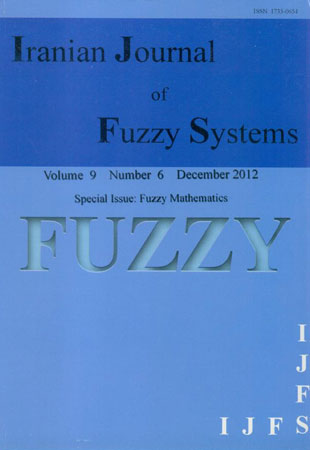فهرست مطالب

Iranian journal of fuzzy systems
Volume:9 Issue: 6, Dec 2012
- Special Issue: Fuzzy Mathematics
- 148 صفحه،
- تاریخ انتشار: 1391/12/20
- تعداد عناوین: 9
-
-
صفحه 43
-
صفحه 69
-
صفحه 123
-
Page 1This paper addresses a new version of the exible ow line prob- lem, i.e., the budget constrained one, in order to determine the required num- ber of processors at each station along with the selection of the most eco- nomical process routes for products. Since a number of parameters, such as due dates, the amount of available budgets and the cost of opting particular routes, are imprecise (fuzzy) in practice, they are treated as fuzzy variables. Furthermore, to investigate the model behavior and to validate its attribute, we propose three fuzzy programming models based upon credibility measure, namely expected value model, chance-constrained programming model and dependent chance-constrained programming model, in order to transform the original mathematical model into a fuzzy environment. To solve these fuzzy models, a hybrid meta-heuristic algorithm is proposed in which a genetic al- gorithm is designed to compute the number of processors at each stage; and a particle swarm optimization (PSO) algorithm is applied to obtain the op- timal value of tardiness variables. Finally, computational results and some concluding remarks are provided.Keywords: Budget, constrained exible ow lines, Credibility, based fuzzy pro, gramming, Meta, heuristic, Genetic algorithm, Particle swarm optimization
-
Page 31In this paper we extend the notion of degrees of membership and non-membership of intuitionistic fuzzy sets to lattices and introduce a residuated lattice with appropriate operations to serve as semantics of intuitionistic fuzzy logic. It would be a step forward to find an algebraic counterpart for intuitionistic fuzzy logic. We give the main properties of the operations defined and prove some theorems to demonstrate our goal.Keywords: Intuitionistic fuzzy logic, Residuated lattice, Intuitionistic fuzzy implication
-
Page 43This paper continues the study of the connection between hyper- groups and fuzzy sets, investigating the length of the sequence of join spaces associated with a hypergroup. The classes of complete hypergroups and of 1-hypergroups are considered and analyzed in this context. Finally, we give a method to construct a nite hypergroup with the strong fuzzy grade equal to a given natural numberKeywords: Complete hypergroup, Join space, Fuzzy set, Fuzzy grade
-
Page 57Ranking fuzzy numbers plays a very important role in decision making and some other fuzzy application systems. Many different methods have been proposed to deal with ranking fuzzy numbers. Constructing ranking indexes based on the centroid of fuzzy numbers is an important case. But some weaknesses are found in these indexes. The purpose of this paper is to give a new ranking index to rank various fuzzy numbers effectively. Finally, several numerical examples following the procedure indicate the ranking results to be valid.Keywords: Ranking, Fuzzy numbers, Centroid point, Defuzzification
-
Page 69In this paper, a new algorithm for edge detection based on fuzzy concept is suggested. The proposed approach defi nes dynamic membership functions for diff erent groups of pixels in a 3 by 3 neighborhood of the central pixel. Then, fuzzy distance and -cut theory are applied to detect the edge map by following a simple heuristic thresholding rule to produce a thin edge image. A large number of experiments are employed to confi rm the robustness of the proposed algorithm. In the experiments diff erent cases such as normal images, images corrupted by Gaussian noise, and uneven lightening images are involved. The results obtained are compared with some famous algorithms such as Canny and Sobel operators, a competitive fuzzy edge detector, and astatistical based edge detector. The visual and quantitative comparisons show the e ffectiveness of the proposed algorithm even for those images that were corrupted by strong noise.Keywords: Edge detection, Fuzzy edge detection, Dynamic membership function, Fuzzy di erence, Noisy images
-
Page 87In this paper a linear Fuzzy Fredholm Integral Equation(FFIE) with arbitrary Fuzzy Function input and symmetric triangular (Fuzzy Interval) output is considered. For each variable, output is the nearest triangular fuzzy number (fuzzy interval) to the exact fuzzy solution of (FFIE).Keywords: Fuzzy number, Expected interval, Fuzzy integral equations, Symmetric fuzzy number, Nystrom method
-
Page 101In this paper, we investigate the L-fuzzy proximities and the relationships betweenL-fuzzy topologies, L-fuzzy topogenous order and L-fuzzy uniformity. First, we show that the category of-fuzzy topological spaces can be embedded in the category of L-fuzzy quasi-proximity spaces as a coreective full subcategory. Second, we show that the category of L -fuzzy proximity spaces is isomorphic to the category of L-fuzzy topogenous order spaces. Finally,we obtain that the category of L-fuzzy proximity spaces can be embeddedin the category of L-fuzzy uniform spaces as a bireective full subcategory.Keywords: L, fuzzy topology, L, fuzzy proximity, L, fuzzy uniformity, L, fuzzy topogenous order, Fuzzy remote neighborhood systems
-
Page 113Let $(X, N)$ be a fuzzy normed space and $A$ be a fuzzy bounded subset of $X$. We define fuzzy $ell^infty$-sums and fuzzy $c_0$-sums of fuzzy normed spaces. Then we will show that in these spaces, all fuzzyuniquely remotal sets are singletons.Keywords: Fuzzy normed spaces, Fuzzy remotal set
-
Page 123The aim of the present paper is to define and study (IC)$LM$-fuzzy topological spaces, a generalization of (weakly) induced $LM$-fuzzy topological spaces. We discuss the basic properties of (IC)$LM$-fuzzy topological spaces, and introduce the notions of interior (IC)-fication and exterior (IC)-fication of $LM$-fuzzy topologies and prove that {bf ICLM-FTop} (the category of (IC)$LM$-fuzzy topological spaces) is an isomorphism-closed full proper subcategory of {bf LM-FTop} (the category of $LM$-fuzzy topological spaces) and {bf ICLM-FTop} is a simultaneously bireflective and bicoreflective full subcategory of {bf LM-FTop}.Keywords: LM, fuzzy topology, (IC) LM, fuzzy topological spaces, (IC), fication of LM, fuzzy topology, Category

